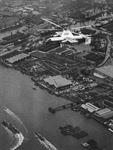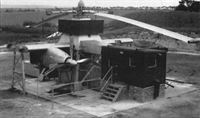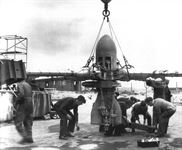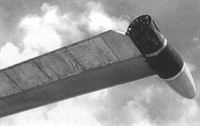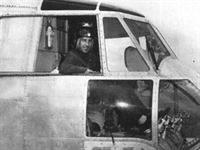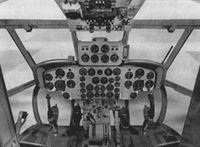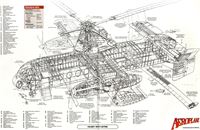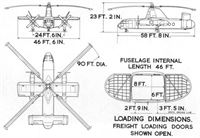
Описание
Страна : Великобритания
Год : 1957
Вертолет
Единственный экземпляр
Экспериментальный винтокрыл с экипажем из двух человек
Fairey Rotodyne
Концепция винтокрыла была проверена на Jet Gyrodyne. Дальнейшим шагом вперед послужило начало в 1947 году доктором Дж. Беннетом и капитаном Э. Г. Форсайтом работ по большим винтокрылам. В декабре 1951 года "British European Airways" выдала спецификацию на 30-40-местный пассажирский самолет для линий малой и средней дальности. "Fairey" в числе других фирм откликнулась на данное предложение. Идеи "Fairey" в целом соответствовали Спецификации, и в 1953 году Министерство снабжения заключило контракт на постройку одного прототипа.
Испытательные стенды организовали в Уайт-Уолтхэме и Боскомб-Дауне. На них предстояло отработать несущий винт, оба двигателя, крыло и т.п. Интенсивные испытания систем шли параллельно постройке прототипа. Первый полет Rotodyne выполнил 6 ноября 1957 года, но первый переход от режима висения к горизонтальному полету состоялся лишь в апреле 1958 года.
Фюзеляж имел сечение, близкое к прямоугольному; на крыле были установлены ТВД Eland, создававшие пропульсивную тягу. Основные опоры трехопорного шасси убирались поворотом вперед в мотогондолы, носовая опора убиралась в фюзеляж прямо под кабиной. Двухкилевое хвостовое оперение позже дополнили третьим, центральным, килем. Кили смонтированы на концах стабилизатора. Большой четырехлопастный несущий винт, необходимый для выполнения вертикальных взлета и посадки, приводился во вращение установленными на законцовках лопастей "мини-двигателями" с соплами. Сжатый воздух для них подавался компрессорами и двигателями Eland: от каждого двигателя воздух шел на две противоположно расположенные лопасти винта, чтобы в случае выхода из строя одного двигателя, у второго хватало мощности для обеспечения работой сопел на двух из четырех лопастей.
Вдохновленные успехами экспериментального Gyrodyne, специалисты "Fairey" решили использовать Rotodyne для установления нового рекорда скорости. Рекорд в классе винтокрылов был установлен 5 января 1959 года - 307,20 км/ч на 100-км замкнутом маршруте. Рекорд продержался до октября 1961 года, когда его побил созданный в СССР Н.И. Камовым винтокрыл Ка-22.
На этой стадии программы будущее Rotodyne выглядело безоблачным: в 1958 году американская "Kaman Aircraft Corporation" заключила соглашение о лицензионном производстве, продаже и техническом сопровождении при эксплуатации винтокрыла в США. "Okanagan Вертолеты" из Ванкувера рассчитывала купить три аппарата, "Japan Air Lines" предполагала использовать винтокрыл на местных линиях; а самым важным потенциальным заказчиком виделась "New York Airways", которая вместе с "Kaman" выразила намерение закупить 5 машин в твердом заказе и плюс опцион на 10 машин в варианте на 54/65 пассажиров и турбовинтовыми двигателями Rolls-Royce Tyne, с началом поставок в 1964 году.
Для разработки нового варианта "Fairey" требовалось 10 млн фунтов стерлингов, половину этой суммы согласилось выделить правительство в случае подтверждения твердого заказа со стороны фирмы BEA - правительственное финансирование было бы в виде займа, который надлежало вернуть с продаж винтокрылов. В 1960 году "Fairey" объединилась с "Westland", а работы по Rotodyne замедлились. В апреле 1960 года свой заказ аннулировала "Okanagan" - по причине затягивания с началом поставок готовых изделий, через пять месяцев аналогичный шаг предприняла "New York Airways". Компания "Westland" тем временем втянулась в вертолетные программы фирмы "Bristol", в ряд других ресурсоемких программ. Все вышеперечисленные факторы в сочетании с ростом массы Rotodyne, для которого уже не хватало мощности двигателей Eland (не подходили и двигатели Tyne), заставили правительство отказаться от поддержки программы. Окончательно все работы по теме Rotodyne прекратили в феврале 1962 года.
ТАКТИКО-ТЕХНИЧЕСКИЕ ХАРАКТЕРИСТИКИ
Fairey Rotodyne
Тип: экспериментальный винтокрыл с экипажем из двух человек
Силовая установка: два ТВД Napier Eland NEI.7 мощностью по 2800 л. с. (2088 кВт)
Летные характеристики: максимальная скорость на оптимальной высоте 298 км/ч; дальность 724 км
Масса: макс, взлетная 14969 кг
Размеры: диаметр несущего винта 27,43 м; размах крыла 14,17 м; длина 17,88 м; высота 6,76 м; площадь, ометаемая несущим винтом, 591,00 м2
Полезная нагрузка: до 40 пассажиров
- Описание
Фотографии
-
Aviation Historian 23 / K.Hayward - A very large & awkward baby
Регистрационный номер: XE521 [38] THE SOLE ROTODYNE AT FARNBOROUGH, 1958.
-
Aeroplane Monthly 2000-01 / P.McDonnell - Requiem for the Rotodyne /Type history/
Регистрационный номер: XE521 [38] The Rotodyne at the 1959 SBAC Display at Farnborough, with rear doors open and tops of fins folded down to clear the rotor at low rotational speeds.
-
Мировая Авиация 125
Регистрационный номер: XE521 [38] Идея разработки большого винтокрыла, способного найти спрос на коммерческом рынке, появилась в 1947 году. В 1953-м фирма запросила у министерства снабжения разрешение на постройку опытного образца. Первый полет 30-40 местный винтокрыл Fairey Rotodyne выполнил в ноябре 1957 года, а первый переход из режима висения в режим поступательного полета - в апреле 1958-го. Винтокрыл Rotodyne, оснащенный двумя турбовинтовыми двигателями Napier Eland, вызвал большой интерес в военных и гражданских кругах, но медленные темпы доводки машины привели к аннулированию программы в 1962 году.
The Fairey Rotodyne will once again be one of the star turns at Farnborough. -
OS 1 / H.Cowin - X-Planes
Регистрационный номер: XE521 [38] The sole Fairey Rotodyne prototype, XE 521, first flew on 6 November 1957, following a period of exhaustive ground testing that dated back to September 1955. The culmination of a Fairey Aviation programme of convertiplane research initiated at the end of 1945, the Rotodyne was built to meet a 1951 British European Airways specification for a 30 to 40 passenger, vertical take-off and landing 'Bealine Bus'. Powered by two 3.000shp Napier Eland N.EI.3 turboprops with modified auxiliary compressor stages at the rear of the engines from which to draw the rotor system air supply. Just forward of this were clutches that enabled switching the engines from the gas generator mode for take-off and landing, to driving the propellers in cruise. Always destined as a technology demonstrator for a larger 65 passenger, or 75 troop carrying production aircraft, the Rotodyne proved its alacrity on 5 January 1959, when it set a new convertiplane 100 kilometre, or 62 mile closed circuit speed record of 190,897mph in the hands of Fairey's Sqn. Ldr. W.R. Gellatly. Two months after this, New York Airways placed a tentative order for 5, but the takeover of Fairey by Westland, inadequate funding and signs of acoustic fatigue over the next year or two saw interest in the Rotodyne evaporate.
-
Air Pictorial 1958-10 / J.Stevens - Some Thoughts on Farnborough
Регистрационный номер: XE521 [38] Fairey Rotodyne shown with undercarriage retracted.
-
Авиация и Космонавтика 2008-07 / Е.Ружицкий - История вертолетных рекордов (9)
Регистрационный номер: XE521 [38] Пассажирский винтокрыл "Ротодайн"
-
Aviation Historian 23 / K.Hayward - A very large & awkward baby
Регистрационный номер: XE521 [38] With the takeover of Fairey by Westland in early 1960, the Rotodyne’s markings were changed to reflect the transfer of the project to the new company, and RAF roundels and fin-flashes were applied to signify military interest.
-
Aviation Historian 23 / K.Hayward - A very large & awkward baby
Регистрационный номер: XE521 [38] The sole Rotodyne prototype, designated as the “Type Y” by Fairey (the production version was to be the “Type Z”) made an appearance at every annual SBAC show at Farnborough during 1958-61, and is seen here peeling away from the camera aircraft during a photographic flight over the Hampshire countryside in 1959.
-
Aeroplane Monthly 2000-01 / P.McDonnell - Requiem for the Rotodyne /Type history/
Регистрационный номер: XE521 [38] An unusually lively study of the Rotodyne gives some impression of its bulkiness and the large rotor diameter.
-
Aeroplane Monthly 2000-01 / P.McDonnell - Requiem for the Rotodyne /Type history/
Регистрационный номер: XE521 [38] Although the Rotodyne was able to give lively performances at Farnborough, when lightly loaded, its Elands were insufficiently powerful.
-
Aviation Historian 23 / K.Hayward - A very large & awkward baby
Регистрационный номер: XE521 [38] In January 1959 the Rotodyne set a new helicopter world speed record over a 100km (62-mile) closed circuit of 191 m.p.h. (307km/h). The Rotodyne was fast, with a great deal of potential for development - but neither industry nor government was prepared to risk so much on such a new commercial and military concept.
-
Aeroplane Monthly 2000-01 / P.McDonnell - Requiem for the Rotodyne /Type history/
Регистрационный номер: XE521 [38] The Rotodyne over Surrey Docks, London, in the autumn of 1959; had it gone into service, this might have been a common sight.
-
Aeroplane Monthly 1982-09 / ??? - Vintage Farnboroughs
Регистрационный номер: XE521 [38] The Fairey Rotodyne's last Farnborough appearance was at the 1961 Farnborough. The Rotodyne programme was cancelled five months later.
-
Aeroplane Monthly 2000-01 / P.McDonnell - Requiem for the Rotodyne /Type history/
Регистрационный номер: XE521 [38] A bridge-lifting demonstration in mid-1959. Note the fin attached to the left end of the bridge to stabilise it in flight.
-
Aeroplane Monthly 1993-03
Регистрационный номер: XE521 [38] Fairey Rotodyne XE521 was first flown on November 6, 1957. It was the only example built, and the programme was cancelled in February 1962.
-
Aviation Historian 19 / K.Hayward - Kill or cure? The view from Whitehall
Регистрационный номер: XE521 [38] In June 1957 London Heathrow Airport was the departure and return point for the Rotodyne when it flew to Brussels and to Paris for the Aero Show, its first overseas flight. The aircraft’s smart “airline” colour scheme made it look the part.
One of the UK’s most ambitious aircraft research and development programmes at the time of the 1957 Defence White Paper was the Fairey Rotodyne, a compound helicopter conceived as a short- to medium-haul airliner capable of operating into and out of city centres. The sole prototype, XE521, first flew in November 1957. -
Aviation Historian 23 / K.Hayward - A very large & awkward baby
Регистрационный номер: XE521 [38] Fairey Rotodyne, holder of the record for speed in a 100 km closed circuit by a convertipiane.
By this time wearing its blue, white and bare-metal colour scheme and bearing “Fairey Rotodyne” titles and its military serial, XE521, the prototype undergoes a flight in June 1959 in preparation for its appearance at the Paris Air Salon. Important orders from New York Airways and Canada’s Okanagan had been placed by this point. -
Aviation Historian 34 / C.Gibson - Every home should have one...
Регистрационный номер: XE521 [38] The idea of a VTOL aircraft for point-to-point travel - in which passengers could be transported directly into the urban fabric of a town or city, rather than having to land at an airport miles from the city centre and travel into the latter on a ground transport network - was explored by Fairey and its Rotodyne compound helicopter. It ultimately proved uneconomical and prohibitively noisy.
-
Jane's All the World Aircraft 1980 / Encyclopedia of Aviation - Aircraft A-Z - v3
Регистрационный номер: XE521 [38] Fairey Rotodyne.
-
Aviation Historian 23 / K.Hayward - A very large & awkward baby
Регистрационный номер: XE521 [38] During its June 1959 trip to the Paris Air Salon, the Rotodyne also dropped in to the Allee Verte (Groendreef) heliport in Brussels, home to Sabena’s helicopter operations since 1953. The visit played well for the type when BEA opened negotiations with Sabena in 1961 to operate a helicopter pooling arrangement for inter-city services. It ultimately came to nothing.
-
Aeroplane Monthly 2000-01 / P.McDonnell - Requiem for the Rotodyne /Type history/
Регистрационный номер: XE521 [38] The first flight of sole prototype XE521 was made on November 6, 1957, in helicopter mode and with a temporary fixed undercarriage, no folding upper fins, and with the cowling panels off. New Zealander Sqn Ldr Ron Gellatly was the pilot.
-
Air Pictorial 1957-12
Регистрационный номер: XE521 [38] The world's first vertical take-off airliner, the Fairey Rotodyne, made its first flight on Wednesday, 6th November. It takes off like a normal helicopter and once airborne, power is gradually transferred to the propellers. For landing, the process is reversed.
-
Aeroplane Monthly 1988-02 / K.Desmond - Richard Fairey 1887-1956 (2)
Регистрационный номер: XE521 [38] The Fairey Rotodyne of 1957 on an early flight.
-
Air Pictorial 1958-05
Регистрационный номер: XE521 [38] 6 ноября 1957г.: экипаж в составе У. Р. Геллатли и Дж. Г. П. Мортона выполнил в Уайт-Уолтхэме первый полет на прототипе винтокрыла Fairey Rotodyne.
The Fairey Rotodyne has successfully achieved transition from vertical to horizontal flight. The upper stabilising fins have been fitted since the Rotodyne made its first flight last year. -
Air Pictorial 1958-07
Регистрационный номер: XE521 [38] Adding achievement to achievement, Fairey Aviation have now built - and flown - potentially the most important transport aeroplane in the world, the Fairey Rotodyne. Carrying 48 passengers or 4 1/2 tons of freight it takes off vertically as a helicopter and having gained height flies forward as a normal twin-engined airliner. It is the most adaptable rotary-wing aircraft in the world and the first to offer operating economy directly comparable to that of fixed wing aircraft over ranges of up to 400 miles. The arrangement within the Rotodyne's capacious fuselage can readily be adapted to suit civil or military applications. Powered by two Napier Eland propeller-turbines with Fairey Pressure-Jets at the flies the first vertical take-off Airliner rotor-tips for take-off and landing.
-
Aeroplane Monthly 2000-01 / P.McDonnell - Requiem for the Rotodyne /Type history/
Регистрационный номер: XE521 [38] On June 3, 1958, with its name emblazoned on its fuselage and rotor pylon, XE521 was demonstrated to the press at White Waltham.
-
Aeroplane Monthly 2000-01 / P.McDonnell - Requiem for the Rotodyne /Type history/
Регистрационный номер: XE521 [38] A test flight during the vibration programme, with the empennage removed and a bracing strut from pylon to tail, to measure stiffness changes.
-
Air Pictorial 1957-09 / J.Stevens - Farnborough 1957
Регистрационный номер: XE521 [38] Fairey Rotodyne which is nearly complete;
-
Aviation Historian 23 / K.Hayward - A very large & awkward baby
Регистрационный номер: XE521 [38] Unsurprisingly for such a radical new concept, the prototype Rotodyne underwent extensive ground testing before its first flight, accruing some 50hr of rotor trials and 100hr of engine-runs, as seen here with both of its Napier Elands running at high power. Still in its bare-metal finish, the prototype first flew on November 6, 1957.
-
Aeroplane Monthly 2000-01 / P.McDonnell - Requiem for the Rotodyne /Type history/
Регистрационный номер: XE521 [38] Final assembly of the airframe well under way at White Waltham in May 1957, with the powerplant still to be installed.
-
Aeroplane Monthly 2000-01 / P.McDonnell - Requiem for the Rotodyne /Type history/
Регистрационный номер: XE521 [38] The Rotodyne spinning rig at Boscombe Down in its initial form in the mid-1950s, with one Eland engine and a two-bladed rotor.
-
Aeroplane Monthly 2000-01 / P.McDonnell - Requiem for the Rotodyne /Type history/
Регистрационный номер: XE521 [38] This study of the rotor head being prepared for one of many tests at Boscombe Down reveals some of its structural and mechanical details.
-
Aeroplane Monthly 2000-01 / P.McDonnell - Requiem for the Rotodyne /Type history/
Регистрационный номер: XE521 [38] A rotor blade under construction, showing the ducts for the air to the pressure jets.
-
Aeroplane Monthly 2000-01 / P.McDonnell - Requiem for the Rotodyne /Type history/
Регистрационный номер: XE521 [38] One of the four rotor-tip pressure jet units largely responsible for one of the Rotodyne’s greatest bugbears: noise.
-
Aeroplane Monthly 2000-01 / P.McDonnell - Requiem for the Rotodyne /Type history/
Регистрационный номер: XE521 [38] The Rotodyne’s 59ft fuselage and 47ft wing on the road from Fairey’s factory at Hayes, Middlesex, to White Waltham Aerodrome, Berkshire, in April 1957 for final assembly.
-
Aeroplane Monthly 2000-01 / P.McDonnell - Requiem for the Rotodyne /Type history/
Регистрационный номер: XE521 [38] Squadron Leader Ron Gellatly, a 36-year-old Dunedin-born New Zealander and Fairey’s senior rotary-wing test pilot, in the Rotodyne cockpit late in 1957.
-
Aeroplane Monthly 2000-01 / P.McDonnell - Requiem for the Rotodyne /Type history/
Регистрационный номер: XE521 [38] The Rotodyne’s cockpit/flightdeck, with its generous glazing allowing the pilot and copilot a good view of the outside world.
-
Aeroplane Monthly 2000-01 / P.McDonnell - Requiem for the Rotodyne /Type history/
Регистрационный номер: XE521 [38] A view from the rear, with the clamshell doors wide open to admit cargo or vehicles.
-
Aeroplane Monthly 2000-01 / P.McDonnell - Requiem for the Rotodyne /Type history/
Two of the leading lights behind the Rotodyne: left, Dr G.S. Hislop, Fairey Helicopters’ chief designer, and, right, Fairey Aviation chief engineer R.L. Lickley.
-
Aeroplane Monthly 2000-01 / P.McDonnell - Requiem for the Rotodyne /Type history/
Optimism unbounded and unfounded; models of production Rotodynes in the colours of BEA and British United Airways at the 1961 Farnborough Show.
-
Aeroplane Monthly 2000-01 / P.McDonnell - Requiem for the Rotodyne /Type history/
This advertisement, published in The Aeroplane of January 9, 1953, depicts an early conception of the Rotodyne on the London-Paris run.
-
Aviation Historian 23 / K.Hayward - A very large & awkward baby
Регистрационный номер: G-AFAC This promotional Fairey item shows an artist’s impression of an early incarnation of the Rotodyne superimposed on a photograph of the Dome of Discovery on London’s South Bank during the Festival of Britain, suggesting this is probably a 1951-vintage proposal. The original design, to be powered by Armstrong Siddeley Mambas, was put forward in 1948.
-
Air Pictorial 1958-01
FAIREY ROTODYNE World's First Vertical Take-Off Airliner
-
Aeroplane Monthly 2000-01 / P.McDonnell - Requiem for the Rotodyne /Type history/
An artist’s impression of the Rolls-Royce Tyne-engined production version of the Rotodyne.
-
Air Pictorial 1959-09 / Farnborough Directory
FAIREY ROTODYNE: Now having its wings set at a new angle of incidence and fitted with ailerons, the Rotodyne is powered by two 3,000-e.h.p. Napier Eland turboprops, and its overall dimensions include a rotor diameter of 104 ft., a fuselage length of 64 ft. 6 in., and an overall height of 23 ft. 2 in.
-
Aeroplane Monthly 2000-01 / P.McDonnell - Requiem for the Rotodyne /Type history/
Fairey Aviation released this Rotodyne drawing in November 1958.
-
Aviation Historian 23 / K.Hayward - A very large & awkward baby
The production “Type Z”, also known as the FA-1, was to be larger overall, with a capacity for up to 70 passengers and powered by Rolls-Royce Tyne turboprops with an RB.176 compressor unit in the rear of each nacelle to power the rotor tipjets. The wing was to be of greater area than that of the “Y”, with tapered leading edges on the outer sections.
- Фотографии











